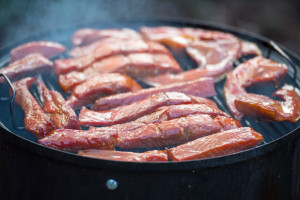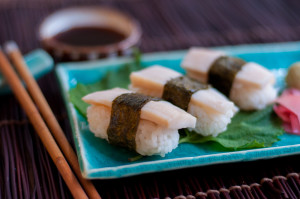 I LIKE TO make salmon candy with the collars and belly strips. It’s sweeter than my usual smoked salmon and makes a good treat while out on a hike or mushroom hunting.
I LIKE TO make salmon candy with the collars and belly strips. It’s sweeter than my usual smoked salmon and makes a good treat while out on a hike or mushroom hunting.
Dry brine:
1 cup pickling salt (or regular, non-iodized)
4 cups dark brown sugar
Glaze:
1/4 cup maple sugar
2 tbsp dark brown sugar
1/4 tsp kosher salt
1/4 cup Grand Marnier
1. Mix the dry brine. My standard brine is a 1:4 ratio of salt to dark brown sugar for a 12 hour brine. Often I’ll add a whole head of chopped garlic and fresh ground pepper to this, and sometimes other spices as well. For salmon candy, I keep it simple: just salt and dark brown sugar.
2. Prepare the salmon. Remove pin bones with pliers and cut fillets into strips (with a large chinook, my strips are 2 to 3 inches wide).
3. Pack the salmon pieces with dry brine in a non-reactive (e.g., Pyrex) dish, skin up for a single layer. If stacking fish in more than one layer, place first layer skin down and second layer skin up, so the fish is flesh to flesh, with the dry brine packed between. Brine overnight or 12 hours. The brine will be soupy by the end.
 4. Remove salmon pieces from dish and rinse with cold water under tap. Place skin down on wire racks to dry for 2 to 4 hours. Don’t cheat on this step. It’s important to let the fish dry and firm up; the exterior should be tacky, not wet. A pellicle forms, which helps retain moisture and flavor during the smoking process. I speed up this step up with an electric fan, but it still takes at least a couple hours.
4. Remove salmon pieces from dish and rinse with cold water under tap. Place skin down on wire racks to dry for 2 to 4 hours. Don’t cheat on this step. It’s important to let the fish dry and firm up; the exterior should be tacky, not wet. A pellicle forms, which helps retain moisture and flavor during the smoking process. I speed up this step up with an electric fan, but it still takes at least a couple hours.
5. Smoke the salmon in your usual way, low and slow if possible. I use a Weber Bullet, which is a hot smoker, meaning the heat from the fire and not just the smoke contributes to the cooking and smoking process, so I try to keep my bed of coals fairly small and heavily damped down. The temperature ranged from 125 to 150 degrees for the first three hours, and then 100 degrees for the last two hours. Cherry or apple wood is good (I used apple this time). A long, low smoke is preferable, especially for candy. While the fish is smoking, brush on glaze periodically, once an hour or so.






